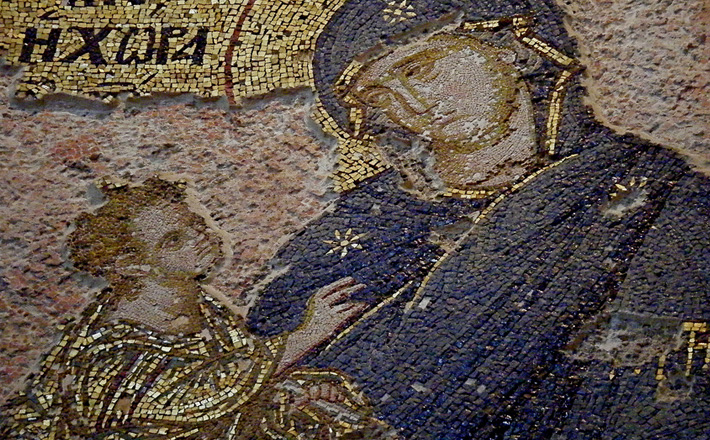Commentary on Titus 2:11-14
As Christians around the world prepare each year to celebrate the birth of Jesus, many are welcoming the familiar rhythms of the liturgical year, the reappearance of annual traditions, and the singing of hymns that signal the arrival of the seasons of Advent and Christmas.
Observing the liturgical calendar is both a means of practicing the traditions of the faith and a reminder that we always live in what theologians call the “now” and the “not yet.” Christ has come and is yet coming again. For millennia, the church worldwide has proclaimed and been shaped by these twin convictions. The transformation to which the church bears witness and that it seeks to embody occurs in this third space, between the “now” and the “not yet.”
The Letter to Titus speaks from the ancient past to the deep longing that emerges from living in the period between the first and future coming of Christ. As is the case with 1 and 2 Timothy, which together with Titus constitute the Pastoral Letters, the authorship of this letter remains uncertain. Whether or not it was written by Paul, the letter expresses both love and concern for Titus and his community. It understands that like all Christians before and since, the community is living in the time between Christ’s first appearance and the future “manifestation of the glory of our great God and Savior, Jesus Christ” (Titus 2:13). After focusing first on how Christ served as the full manifestation (epiphaneia) of God’s grace, the letter speaks to how Jesus “gave himself for us that he might redeem us from all iniquity and purify for himself a people of his own who are zealous for good deeds” (2:14). Thus the writer deftly ties the theological claim that Jesus made visible God’s grace with the image of Jesus as the model for right behavior.
This comprehensive picture of the role and purpose of Jesus is central to the lectionary passage for December 24, the Nativity of Our Lord, for it provides the foundation for what the writer exhorts Titus to do. After outlining a set of moral instructions for various groups in Titus’ community (the older men, Titus 2:2; older and younger women, 2:3-5; younger men, 2:6-8; and slaves, 2:9-10), the writer proceeds to explain why he has done so. He writes, “For the grace of God has appeared, bringing salvation to all” (2:11). It is because salvation is intended for all—both those inside and outside of the community of faith—that the writer’s moral instruction coheres with Hellenistic social convention at the time. For example, the letter’s instructions align with the moral ideals associated with the exemplary household, which was considered the building block of Hellenistic society. The letter is clearly concerned with the community’s conduct that can be observed by those outside of it. Although the writer’s interest may be due, in part, to protecting the community from suspicion, the letter is also invested in the persuasive power of the community’s witness to outsiders. The community is to embody the grace of God that Christ has made known and live out the example that he has provided for them.
The conventional values that the letter upholds would have come as no surprise to either Titus’s community or those outside of it. The innovation of the exhortation here in chapter 2 is not its end, but the means by which such ideals are to be lived out. In the period of waiting for Christ’s return, it is nothing less than God’s grace that is “training us to renounce impiety and worldly passions, and in the present age to live lives that are self-controlled, upright, and godly” (Titus 2:12). The interim period is a time for being trained in the example of Jesus.
Lest readers think that because his instruction coheres with moral ideals espoused in the broader culture, that the writer’s exhortation must have no teeth, the letter proceeds to name the passions of the present age that run counter to its teaching. Recalling the qualities that characterized their lives before their transformation and renewal by the Holy Spirit, he writes that “we ourselves were once foolish, disobedient, led astray, slaves to various passions and pleasures, passing our days in malice and envy, despicable, hating one another” (Titus 3:3). Life lived in Christian community is to serve as a visible contrast to the former ways. In addition, with the letter’s focus on internal division, the writer draws an even sharper contrast to the doing of good works which “are excellent and profitable to everyone” and “stupid controversies, genealogies, dissensions, and quarrels about the law, for they are unprofitable and worthless” (3:9).
The letter’s focus on transformation, paired with the conviction that the interim period between the first and future coming of Christ is a time of training for the Christian community can be a welcome word at Christmas. We are, of course, surrounded by ample evidence in our world of how much is in need of transformation. From environmental degradation to military conflicts to injustice around the world and so much more, we see at Christmas, as we see throughout the year, how much is unchanged. Perhaps more to the point, though, the letter asks us to look at the places in our own lives and church communities that remain unchanged. In North America and Europe, church attendance continues to steadily decline and polls show how public trust in organized religion is dropping. With its focus on matters internal to the Christian community and on what outsiders see in those who profess to follow Christ, the Letter to Titus challenges us to look within. As we celebrate the birth of Jesus and look forward to his future coming, the letter reminds us that this interim time is our training ground. May “those who have come to believe in God … be careful to devote themselves to good works” (Titus 3:8).


December 24, 2019